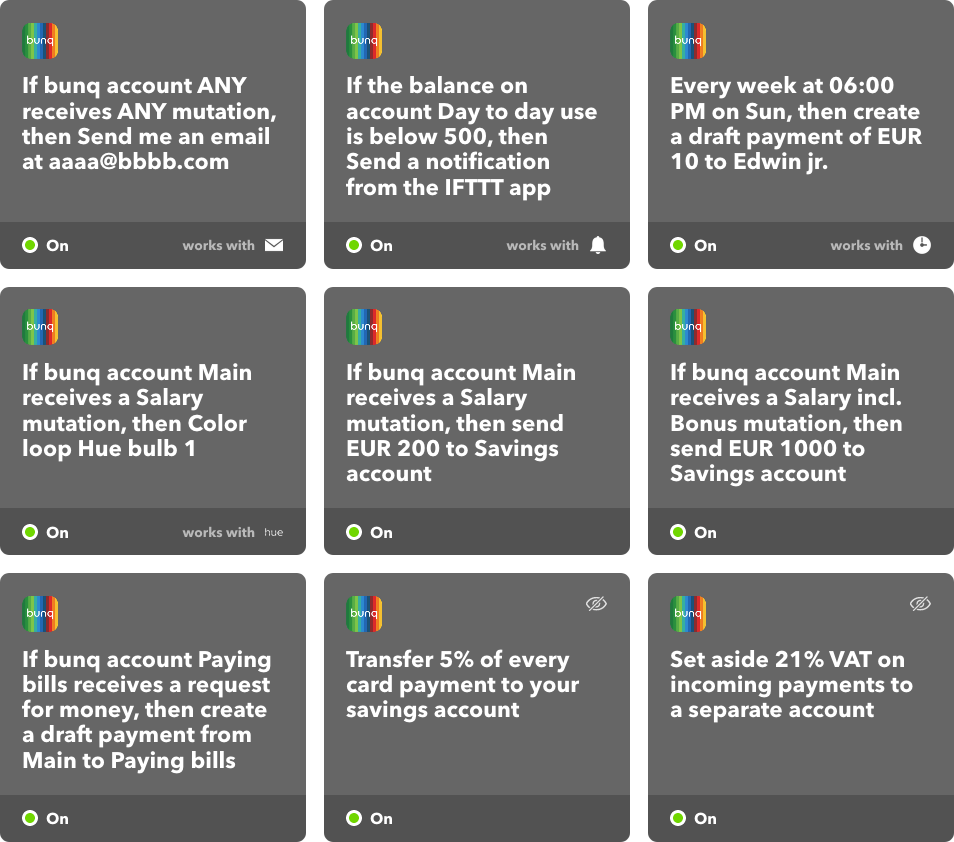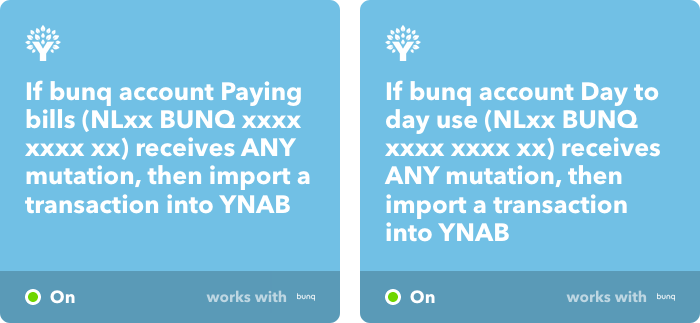Examples and Tutorial - woudt/bunq2ifttt GitHub Wiki
Below are some examples of what you can do with bunq2IFTTT. They start simple, but at the bottom are some more complex examples where arithmetic is used to determine the amount to transfer. Therefore these examples also serve as a tutorial, explaining the different things you can do with bunq2IFTTT.

Receive an email for every mutation
This is a very simple example, where you will receive an email for any mutation on any of your accounts.
- In IFTTT, under 'My Applets' click on 'New Applet'
- Click on 'This'
- Step 1: choose your service (e.g. bunq_acme)
- Step 2: choose the 'bunq mutation' trigger
- leave all defaults as they are, to select all mutations, and click 'Create trigger' at the bottom
- Click on 'That'
- Step 3: choose the 'Email' service
- Step 4: choose the 'Send me an email' action
- Step 5: the defaults should work if you entered them in your configuration, but here is something you can copy/paste:
- Subject:
bunq mutation - Body:
- Subject:
Created: {{CreatedAt}}<br>
Type: {{Type}}<br>
Account: {{Account}}<br>
Amount: {{Amount}}<br>
Balance after mutation: {{Balance}}<br>
Counterparty account: {{CounterpartyAccount}}<br>
Counterparty name: {{CounterpartyName}}<br>
Description: {{Description}}
- click 'Create action' at the bottom
- Step 6: click 'Finish' at the bottom
Congratulations, you now have created your first applet with bunq2IFTTT! Check if this one works, before you move to the more complex examples below.
In case it doesn't work:
- check if the applet looks like this screenshot (use the edit button on the top of your applet to see a complete overview of the applet like this)
- check the logs in the google cloud console if you see any errors
Receive a notification if the balance is below a certain amount
To receive a signal once a balance goes below a certain amount, use the following:
- use the 'bunq balance' trigger
- set 'balance comparator' to 'below'
- set 'balance value' to e.g. 500
- use for example the 'Notifications' service to receive a notification in the IFTTT app
For a complete result, see the screenshot
Create a draft payment every week for pocket money for your kid
Let's say that you want to give your kid pocket money every week. We will create a draft payment for this, not only because it is more secure than a direct payment (see [Security]), but also so you can verify if he/she has been nice this week :)
- use the 'Date/time' service, and the 'Every day of the week at' trigger
- set the desired day and time, e.g. Sunday at 6PM
- from your bunq service, use the 'bunq draft payment' action
- fill in amount, your and your kids account details and a description
For a complete result, see the screenshot
Now every Sunday at 6PM, you will receive a notification in your bunq app to approve a payment to your kid!
Once your salary has been received, turn on a Hue colorloop
With the large number of services available in IFTTT, you can also connect bunq to your IoT / home automation devices. For example:
- IF you receive a payment with 'Salary' in the description
- THEN turn on a color loop on your hue lights
This should be straightforward to configure if you understand the above examples, but here's a screenshot
Auto-save a part of your salary, save more when you receive a bonus
Automatically saving a part of your salary is a good custom, and possibly your way to financial independence. Let's make this case a bit more complicated, by saving an amount that depends on how much salary you receive:
- Save 200 euro if you receive your normal salary
- Save 1000 euro if you receive your salary + bonus
We do this by using the double compare value, so we transfer 200 euro in case the following is triggered:
- Set 'balance comparator' to 'above'
- Set 'balance value' to an amount below your salary, e.g. 2000
- Set 'balance comparator 2' to 'below'
- Set 'balance value 2' to an amount above your salary but below your salary + bonus, e.g. 4000
Again, here is a screenshot with the total applet.
Now create a second applet to transfer 1000 euro, with the following conditions:
- Set 'balance comparator' to 'above'
- Set 'balance value' to e.g. 4000
Once a request for money is received, create a draft payment to fund it
The way I handle requests is that I always approve them by hand. I also use a separate 'paying bills' account for most of the requests, which normally always has a zero balance. Therefore, anytime a request comes in, I must transfer money to that account before I can pay it. Now of course this can be automated!
- As trigger, use the 'bunq request' trigger, and set the account you want to receive requests for
- As action, use the 'draft payment' trigger, for which I use the following parameters:
- Amount: click 'Add ingredient' and select 'Amount', to transfer exactly the requested amount
- Source account: choose the account the money comes from
- Target account: click 'Add ingredient' and select 'Account', to transfer the money to the right account
- Target name: your name
- Description: use anything you want, I use the CounterpartyName ingredient, so I know what the money is for
For a complete result, see the screenshot
Advanced: auto-save 5 percent of every card payment
Now bunq has an auto-save mode, but if you don't like their 'rounding' method, or if you want to use it only on specific payment types (e.g. card payments), then you can use bunq2IFTTT to create a custom saving applet yourself!
Because this requires doing a calculation, a normal applet will not work. However, on IFTTT platform you can create private applets that include some TypeScript.
In order to do so, you need to create a private applet on IFTTT platform:
- On the top of the screen, select the dropdown with your development organization, and select 'Personal Applets'
- Click on 'New applet'
- As trigger, select 'bunq mutation'
- Set all fields to 'Customizable by user' (you will set the account and filters later, because in a private applet you cannot select anything from a dropdown list)
- As action, select 'bunq internal payment'
- Set the amount to 'Set by you' and enter the amount '0'
- Then go back to filter code, and add the following (note: replace BunqAcme with your service name):
BunqAcme.bunqInternalPayment.setAmount(String(
Math.round(-parseFloat(BunqAcme.bunqMutation.Amount) * 5) / 100
))
- Finally, fill in a title and description at the bottom and click 'Save'
The next step is to use the applet:
- On the overview page of your private applet, click on 'Enable it on IFTTT'
- Fill in all the details, e.g. select your accounts and select 'CARD_PAYMENT' as the type
Some screenshots are also available to see if you did it right:
- screenshot of the private applet on IFTTT platform
- screenshot of the resulting enabled applet
Advanced: put VAT aside in a separate account on incoming payments
Another advanced example that uses arithmetic, is for business users to calculate the VAT on your incoming payments and set it aside in a separate account.
Again, this requires you to create a private applet on IFTTT platform:
- On the top of the screen, select the dropdown with your development organization, and select 'Personal Applets'
- Click on 'New applet'
- As trigger, select 'bunq mutation'
- Set all fields to 'Customizable by user' (you will set the account and filters later, because in a private applet you cannot select anything from a dropdown list)
- As action, select 'bunq internal payment'
- Set the amount to 'Set by you' and enter the amount '0'
- Then go back to filter code, and add the following (note: replace BunqAcme with your service name):
BunqAcme.bunqInternalPayment.setAmount(String(
Math.round(parseFloat(BunqAcme.bunqMutation.Amount) / 1.21 * 21) / 100
))
The next step is to use the applet:
- On the overview page of your private applet, click on 'Enable it on IFTTT'
- Fill in all the details, e.g. select your accounts and select 'TRANSFER_REGULAR' and/or 'ONLINE' as the type and set the amount comparator to 'above' and amount value to '0' - all so it works only on incoming payments only
Some screenshots are also available to see if you did it right:
- screenshot of the private applet on IFTTT platform
- screenshot of the resulting enabled applet
Extra: real-time import of bunq transactions in YNAB
The power of IFTTT is to connect different services with each other.
By using another private service - IFTTT2YNAB - you can easily create an importing mechanism for transactions into YNAB (You Need A Budget), by connecting the bunq mutation trigger with the ynab create transaction action.
See https://github.com/woudt/ifttt2ynab
